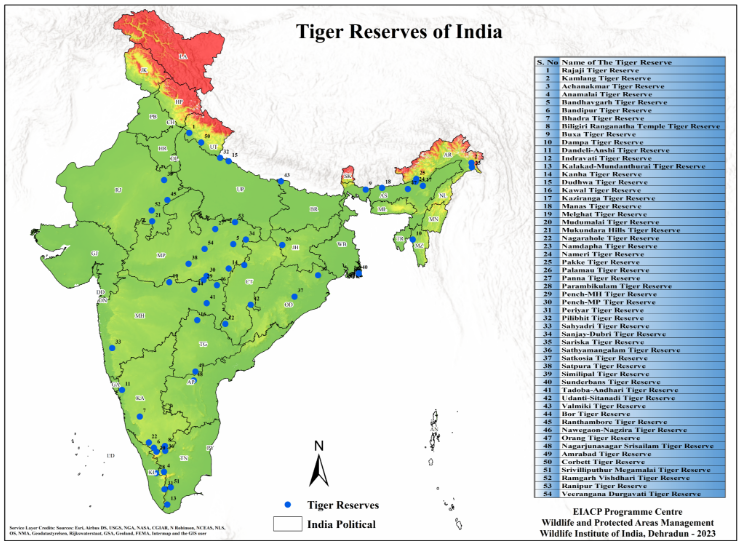The tiger, scientifically known as Panthera tigris, is a beautiful and powerful animal with a thick yellow-orange coat and dark black stripes on its body. It moves with grace, strength, and speed, which is why it is respected and recognized as the national animal of India.
There are 8 types of tigers found around the world. Among these eight types of tigers, the Royal Bengal Tiger is the most common in India. It lives in many parts of the country except for the northwestern regions and can also be found in nearby countries like Nepal, Bhutan, and Bangladesh. The Bengal Tiger is a strong hunter and can grow up to 10 feet (3 meters) long and weigh as much as 570 pounds (260 kilograms). Its bright orange fur with bold black stripes makes it easy to recognize.
To protect this endangered animal, India launched ‘Project Tiger’ in April 1973. This project has helped set up 55 tiger reserves across the country, covering an area of 78,735 square kilometers. These reserves are built in a safe environment where tigers can live and grow freely. It is important to note that India has 75% of the world’s tiger population. A recent report showed that the number of tigers in India increased from 2,226 in 2014 to 3,167, showing a 42% rise, which is a big success in tiger conservation.

Tiger Reserves in India
India is home to a diverse range of wildlife, including the Bengal tiger, one of the most majestic and endangered big cats in the world. To protect these iconic animals, the Indian government has established several tiger reserves across the country. When the project tiger was started in the year 1973 there were only 9 tiger reserves in the entire country. This number has jump to 55 as of August 2024. Dholpur-Karauli is the 55th tiger reserve in India Approved by National Tiger Conservation Authority on 22 August 2023.

| S. No. | Name of Tiger Reserve | State | Year of Inclusion under Project Tiger |
| 1. | Nagarjunsagar Srisailam Tiger Reserve | Andhra Pradesh | 1982-1983 |
| 2. | Kamlang Tiger Reserve | Arunachal Pradesh | 2016-2017 |
| 3. | Namdapha Tiger Reserve | 1982- 1983 | |
| 4. | Pakke Tiger Reserve | 1999-2000 | |
| 5. | Kaziranga Tiger Reserve | Assam | 2008-2009 |
| 6. | Manas Tiger Reserve | 1973-1974 | |
| 7. | Nameri Tiger Reserve | 1999-2000 | |
| 8. | Orang Tiger Reserve | 2016 | |
| 9. | Valmiki Tiger Reserve | Bihar | 1989-1990 |
| 10. | Achanakmar Tiger Reserve | Chhattisgarh | 2008-2009 |
| 11. | Indravati Tiger Reserve | 1982-1983 | |
| 12. | Udanti-Sitanadi Tiger Reserve | 2008-2009 | |
| 13. | Palamau Tiger Reserve | Jharkhand | 1973-1974 |
| 14. | Bandipur Tiger Reserve | Karnataka | 1973-1974 |
| 15. | Bhadra Tiger Reserve | 1994-1995 | |
| 16. | Biligiri Ranganatha Temple Tiger Reserve | 2010-2011 | |
| 17. | Dandeli-Anshi (Kali) Tiger Reserve | 2008-2009 | |
| 18. | Nagarahole Tiger Reserve | 2008-2009 | |
| 19. | Parambikulam Tiger Reserve | Kerala | 2008-2009 |
| 20. | Periyar Tiger Reserve | 1978-1979 | |
| 21. | Bandhavgarh Tiger Reserve | Madhya Pradesh | 1993-1994 |
| 22. | Kanha Tiger Reserve | 1973-1974 | |
| 23. | Panna Tiger Reserve | 1993-1994 | |
| 24. | Pench Tiger Reserve | 1992-1993 | |
| 25. | Sanjay-Dubri Tiger Reserve | 2008-2009 | |
| 26. | Satpura Tiger Reserve | 1999-2000 | |
| 27. | Veerangana Durgavati Tiger Reserve | – | |
| 28. | Bor Tiger Reserve | Maharashtra | 2014 |
| 29. | Melghat Tiger Reserve | 1973-1974 | |
| 30. | Nawegaon-Nagzira Tiger Reserve | 2013-2014 | |
| 31. | Pench Tiger Reserve | 1998-1999 | |
| 32. | Sahyadri Tiger Reserve | 2009-2010 | |
| 33. | Tadoba-Andhari Tiger Reserve | 1993-1994 | |
| 34. | Dampa Tiger Reserve | Mizoram | 1994-1995 |
| 35. | Satkosia Tiger Reserve | Odisha | 2008-2009 |
| 36. | Similipal Tiger Reserve | 1973-1974 | |
| 37. | Mukundra Hills Tiger Reserve | Rajasthan | 2013-2014 |
| 38. | Ramgarh Vishdhari Tiger Reserve | 2022 | |
| 39. | Ranthambore Tiger Reserve | 1973-1974 | |
| 40. | Sariska Tiger Reserve | 1978-1979 | |
| 41. | Anamalai Tiger Reserve | Tamil Nadu | 2008-2009 |
| 42. | Kalakad-Mundanthurai Tiger Reserve | 1988-1989 | |
| 43. | Mudumalai Tiger Reserve | 2008-2009 | |
| 44. | Sathyamangalam Tiger Reserve | 2013-2014 | |
| 45. | Srivilliputhur Megamalai Tiger Reserve | 2020-2021 | |
| 46. | Amrabad Tiger Reserve | Telangana | 2014-2015 |
| 47. | Kawal Tiger Reserve | 2012-2013 | |
| 48. | Dudhwa Tiger Reserve | Uttar Pradesh | 1987-1988 |
| 49. | Pilibhit Tiger Reserve | 2014 | |
| 50. | Ranipur Tiger Reserve | 2022-2023 | |
| 51. | Corbett Tiger Reserve | Uttarakhand | 1973-1974 |
| 52. | Rajaji Tiger Reserve | 2015 | |
| 53. | Buxa Tiger Reserve | West Bengal | 1982-1983 |
| 54. | Sunderbans Tiger Reserve | 1973-1974 | |
| 55. | Dholpur – Karauli Tiger Reserve | Rajasthan | 2023 |
Scientific Classification of the Royal Bengal Tiger
| Taxonomic Rank | Classification |
|---|---|
| Kingdom | Animalia |
| Phylum | Chordata |
| Clade | Synapsida |
| Class | Mammalia |
| Order | Carnivora |
| Family | Felidae |
| Genus | Panthera |
| Species | Panthera Tigris |
| Subspecies | Panthera Tigris Tigris |
Schemes for Tiger Reserves in India
The government has created some schemes for the preservation of Tigers in the country. Here is the list of schemes candidates must go through for preparation:
| Schemes | Tiger Reserves |
| Project Tiger | Project Tiger was launched on 1 April 1973. This project aims to preserve the tiger population in India. It is a centrally funded initiative that supports in situ conservation in selected tiger reserves across “tiger range States.” The program is managed by the National Tiger Conservation Authority (NTCA). |
| Tiger Census | Since 2006, the NTCA and the Wildlife Institute of India (WII), with support from state forest departments and conservation NGOs, have been conducting India’s Tiger Census every four years to monitor the tiger population. |
| M-STrIPES | This was introduced in the year 2010, M-STrIPES (Monitoring System for Tigers – Intensive Protection and Ecological Status) is a software-based system aimed at enhancing patrolling and monitoring in tiger reserves. It focuses on better oversight and protection of the Bengal tiger. |
| St. Petersburg Declaration on Tiger Conservation | At the 2010 Petersburg Tiger Summit, 13 tiger-range countries, including India, pledged to take actions to protect wild tigers and to double their population by the end of 2022. The declaration adopted “TX2” as its motto. |
Some Interesting Facts
- The Bengal Tiger was declared the national animal of India in April 1973.
- International Tiger Day is celebrated each year on July 29 to turn the spotlight on the conservation of tigers worldwide.
- Since 2010, the Royal Bengal Tiger has been classified as an endangered animal by the IUCN.
- Male Bengal tigers have an average length of 2.7m to 3.1m including the tail, while females measure 2.4m to 2.65m on average.




 How can I get selected for Delhi Police ...
How can I get selected for Delhi Police ...
 SSC CHSL Vs. SSC CGL – What Changes in S...
SSC CHSL Vs. SSC CGL – What Changes in S...
 Importance of Solving Previous Year Pape...
Importance of Solving Previous Year Pape...









